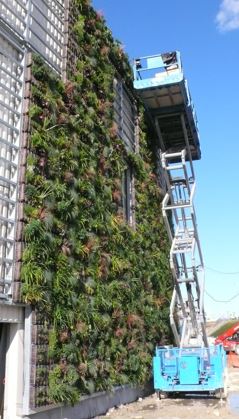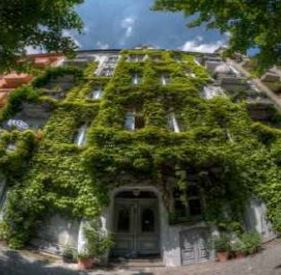Green façades and greens walls are part of the so-called vertical greening techniques. Green façades are made up of climbing plants that cling:
- directly to the facade, thanks to adventitious roots (spikes or suction cups) allowing anchoring along the facade;
- along a support fixed to the façade, by rolling up or clinging to it thanks to their specialised organs (tendrils, voluble petioles);
- usually made of stainless steel cables and/or bars.


Figures: implementation of the elements of a green wall under construction at teh Shopping Mall "Les Sentiers" in Claye-Souilly; and Green façade with climbing plant.
When it is not possible to root the plants in the soil, they are placed in planters, long pots, with a substrate of at least 50cm, large enough to provide the plants with a sufficient supply of water and nutrients for their development.
Green walls (or living walls) are plants that are rooted in a substrate attached to the façade. The green wall requires a hydroponic fertigation system, allowing fertiliser to be applied via an irrigation system. Different technologies are available:
- panel: metal panel filled with an organic or non-organic substrate, requiring constant watering and fertilisation;
- soil cell: cell filled with a substrate, also requiring constant watering and fertilisation;
- planter box: planter integrated into the façade, with an organic-mineral substrate;
- felt layer: polyamide felt placed on a PVC support serving as a rooting and retention substrate for water and minerals (requires a large quantity of water and fertilisers).
In terms of mitigation, green walls and façades contribute very moderately, by using part of the sun's radiation for photosynthesis and by creating shaded areas on the walls, the plants allow to reduce the temperatures inside the building, and thus to reduce the energy needs linked to air conditioning or any other system of regulation of the interior temperature. It should also be noted that green façades have a relatively high carbon footprint, particularly due to the manufacturing process of the substrate which emits greenhouse gases.
In terms of adaptation, green walls and green facades allow less radiation to be reflected towards neighbouring buildings and pedestrians. They help to improve pedestrian comfort in hot weather and to some extent reduce the urban heat island effect.
Comments ()